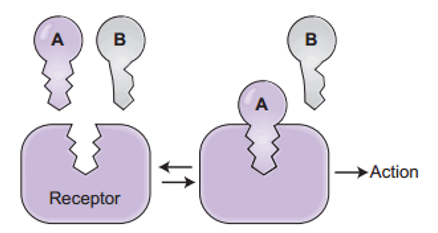Movement across membranes, channels and transporters
1/16
There's no tags or description
Looks like no tags are added yet.
Name | Mastery | Learn | Test | Matching | Spaced |
|---|
No study sessions yet.
17 Terms
Transmembrane Proteins
Transmembrane domain (TMD):
an alpha helical peptide sequence that is largely hydrophobic (uncharged) and spans the membrane; consists of amino acids with hydrophobic side chains (also uncharged)
Permanently attaches the protein to the plasma membrane
Hydrophobic fatty acid tails interacts with hydrophobic TMD
Can facilitate protein-protein interactions
These alpha helices make up a dimer
Movement of Substances Across Cell Membranes
Lipid bilayers do not allow many compounds/molecules to pass through them freely
Small, uncharged molecules cross membranes relatively easily (H2O, oxygen, carbon dioxide, nitrogen monoxide)
Large/polar/charged compounds cannot easily cross lipid bilayer
Specific mechanisms are required for the controlled transport of many substances across membranes
4 basic mechanisms for moving molecules across membranes
simple diffusion
diffusion through a channel
facilitated diffusion
active transport (REQUIRES ENERGY)
Passive Mechanisms
Passive movement of substances across cell membranes relies on molecular concentrations of the substance across the membrane
moves from a high to low concentration (down concentration gradient)
DOES NOT require energy
Passive Mechanisms: Simple Diffusion
Down a concentration gradient—flow is downhill (no energy required)
Simple diffusion works only for very small and uncharged molecules like water, oxygen, and carbon dioxide
aquaporins are specific water channels; water moves through aquaporin channels in “single file” down the concentration gradient
Passive Mechanisms: Channels
channels are formed by integral membrane proteins (typically multiple subunits) that line an aqueous pore
This mode is particularly effective for small, charged molecules like sodium, potassium, chlorine
Ions move down concentration gradients
Channels are selective. allowing only particular types of ions to pass
Passive Mechanisms: Ion Channels
ion channels are often gated (can be opened or closed)
in other words, they can be turned on/off in response to different signals/stimuli
2 types of gated ion channels:
voltage gated channels
ligand-gated channels
Voltage-gated channels
Some channels can respond to changes in charge across membrane
e.x. action potentials in neurons
under non-depolarized conditions, neurons have low sodium inside
sodium wants to enter, causing a change in charge allowing the voltage gate to open causing the inside to be relatively more positive
Ligand-gated Channels
The channel responds to binding of specific molecules on its surface — a ligand
binding of a ligand produces conformational change in the structure of the receptor/channel

Toxins Targeting Ion Channels — Tetrodotoxin
Tetrodotoxin (TTX) is a very potent neurotoxin
the molecule was discovered in the pufferfish, but it is also found in several other aquatic animals like blue-ringed octopuses and moon snails
TTX is a sodium channel blocker. It inhibits the firing of action potentials in neurons by binding to the voltage-gated sodium channels in nerve cell membranes and blocking the passage of sodium ions into the neuron. This prevents the nervous system from carrying messages to muscles, including the diaphragm. TTX intoxication consequently causes death via respiratory failure
Toxins Targeting Ion Channels — Curare
Curare is a mixture of organic compounds found in different plants originating from Central and South America like members of the Strychnos species
Was used as a paralyzing poison and hunting tool before modern techniques
Curare is a competitive antagonist (inhibitor) of the nicotinic acetylcholine receptor (nAChR). It occupies the same position on the receptor as ACh with an equal or greater affinity, and elicits no response. It is a non-depolarizing muscle relaxant
Passive Mechanisms: Carriers
Facilitated diffusion:
Compound binds specifically to integral membrane protein called a facilitative transporter
Change in transporter conformation allows compound to be released on other side of membrane
Compound moves down a concentration gradient; no energy requirement
Carriers: Glucose Transporter
Most animal cells import glucose from the blood into cells down a concentration gradient via a facilitative transporter
Transporter ready to accept glucose molecule
Glucose is accepted by transporter
Intracellular side of transporter opens
Glucose is released and cycle continues
The opening facing the intracellular space is an unstable conformational change, so it returns to be open extra cellularly to accept more glucose
Carrier: Symporter
Under certain circumstances, cells need to move substances from a lower concentration to higher concentrations. Thus, against the concentration gradient
e.x. reabsorption of glucose in kidney cells after blood filtration to prevent its loss through urine
In this case, cells can’t rely on concentration gradient of glucose as kidney cells would stop reabsorbing glucose when an extracellular and intracellular equilibrium is reached
solution: rely on chemical gradient of a second molecule that wouldn’t reach extracellular and intracellular equilibrium
both molecules are transported in the SAME direction
Sodium Glucose Symporter
Simultaneous binding of 2 sodium and 1 glucose to the transporter with outward-facing binding sites
This causes a conformational change in the transporter (occluded conformation)
Eventually the transporter adopts an inward facing conformation that allows the dissociation of the 2 sodium molecules in the cytosol. As a result, the glucose molecule gets pushed in as well
Return to the outward-facing conformation to repeat the cycle
Carrier: Antiporter
The concentration gradient of one molecule is used to transfer a second molecule in opposite directions
An example is the sodium proton exchanger in the nephron of the kidney. This antiporter transports sodium into the cell and protons out of the cell. This carrier is specifically responsible to maintain pH and sodium levels in specific kidney cells
Movement of substances Across Cell membranes: Active Mechanisms
Active transport:
Compound binds specifically to integral membrane protein called an active transporter
Change in the conformation of the transporter caused by the hydrolysis of an ATP molecule allows molecules to be released on other side of the membrane
Using this mechanism, compounds can move against a concentration gradient
requires input of energy in the form of ATP molecules
Example of Active Transport: sodium potassium pump
the sodium/potassium ATPase maintains cellular sodium and potassium using ATP